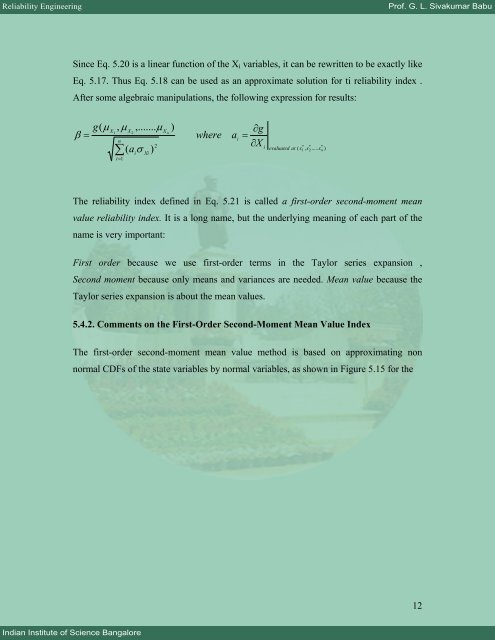Module 5 - E-Courses
Module 5 - E-Courses
Module 5 - E-Courses
You also want an ePaper? Increase the reach of your titles
YUMPU automatically turns print PDFs into web optimized ePapers that Google loves.
Reliability Engineering Prof. G. L. Sivakumar Babu<br />
Indian Institute of Science Bangalore<br />
Since Eq. 5.20 is a linear function of the Xi variables, it can be rewritten to be exactly like<br />
Eq. 5.17. Thus Eq. 5.18 can be used as an approximate solution for ti reliability index .<br />
After some algebraic manipulations, the following expression for results:<br />
g(<br />
µ X , µ ,....... )<br />
1 X µ<br />
2<br />
β =<br />
( a σ )<br />
n<br />
∑<br />
i=<br />
1<br />
i<br />
Xi<br />
where<br />
a<br />
∂g<br />
=<br />
X n<br />
2<br />
i<br />
∂X<br />
i<br />
* * *<br />
evaluated at ( x1<br />
, x2<br />
..... xn<br />
)<br />
The reliability index defined in Eq. 5.21 is called a first-order second-moment mean<br />
value reliability index. It is a long name, but the underlying meaning of each part of the<br />
name is very important:<br />
First order because we use first-order terms in the Taylor series expansion ,<br />
Second moment because only means and variances are needed. Mean value because the<br />
Taylor series expansion is about the mean values.<br />
5.4.2. Comments on the First-Order Second-Moment Mean Value Index<br />
The first-order second-moment mean value method is based on approximating non<br />
normal CDFs of the state variables by normal variables, as shown in Figure 5.15 for the<br />
12

















